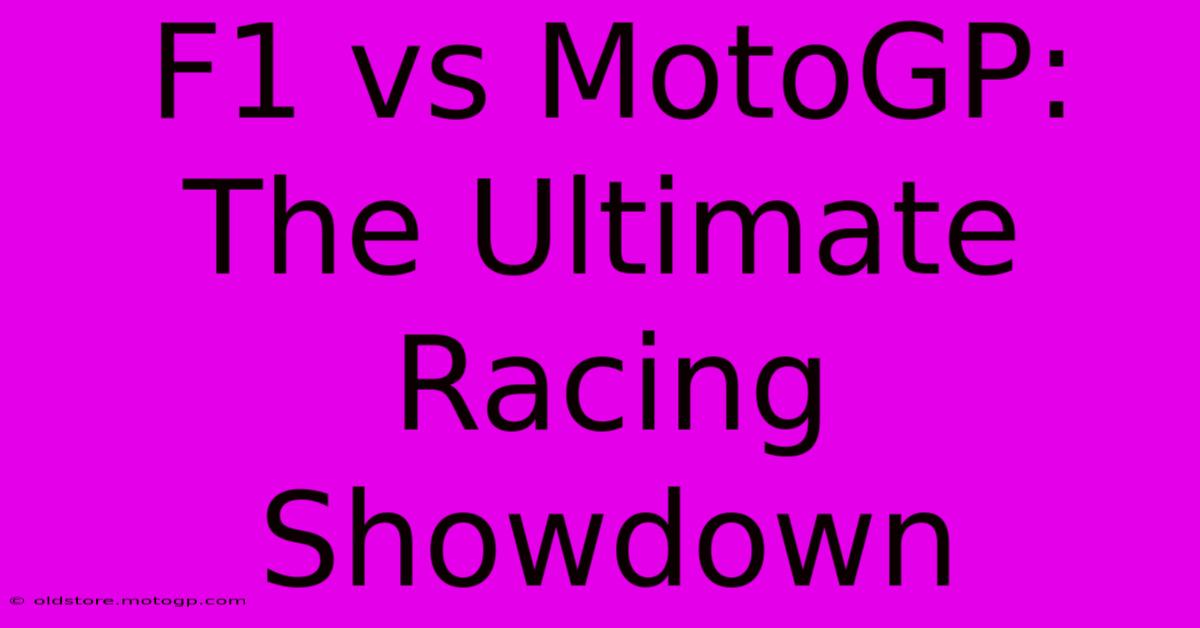F1 Vs MotoGP: The Ultimate Racing Showdown

Table of Contents
F1 vs MotoGP: The Ultimate Racing Showdown
For motorsport enthusiasts, the question often arises: which is superior, Formula 1 or MotoGP? This isn't simply a matter of preference; it's a clash of titans, two vastly different yet equally exhilarating disciplines vying for the title of ultimate racing spectacle. This article dives deep into the heart of this debate, comparing F1 and MotoGP across various key aspects.
The Machines: Power and Precision
Formula 1: These technologically advanced single-seater cars are the pinnacle of automotive engineering. Boasting hybrid power units combining internal combustion engines with complex energy recovery systems (ERS), they deliver breathtaking speed and acceleration on purpose-built circuits. Aerodynamics play a crucial role, with intricate designs maximizing downforce for cornering speeds that defy belief. F1 cars are all about raw power and precision engineering.
MotoGP: In stark contrast, MotoGP bikes represent a thrilling blend of raw power and rider skill. These powerful machines, often exceeding 300km/h on straights, are significantly less technologically advanced than F1 cars, but demand an unparalleled level of rider control and finesse. While electronics play a role, the rider's ability to manage throttle, brakes, and body position is paramount. MotoGP is a symphony of man and machine, a ballet of controlled chaos.
Key Differences in Technology:
- Downforce: F1 cars generate significantly more downforce, allowing for higher cornering speeds. MotoGP bikes rely more on rider skill and tire grip.
- Electronics: F1 utilizes sophisticated electronics for various systems, including the ERS. MotoGP employs electronics for traction control and other rider aids, but to a lesser extent.
- Tyres: Both use specialized racing tires, but the demands and technology are quite different. F1 tires are designed for high-speed cornering, while MotoGP tires must handle extreme acceleration, braking, and lean angles.
The Drivers/Riders: Skill and Courage
F1 drivers are elite athletes, possessing exceptional reaction times, strategic thinking, and mental fortitude. The demands of driving an F1 car are physically intense, requiring immense strength and stamina. Their role is as much about managing the car's systems as it is about pure driving skill.
MotoGP riders are a breed apart. Their skillset includes not only incredible speed and precision but also exceptional balance, agility, and bravery. The physical demands are equally strenuous, requiring immense core strength and the ability to endure extreme g-forces. MotoGP riders are masters of precision, pushing their machines and themselves to the absolute limit.
The Human Element:
- Physical Demands: Both require peak physical fitness, but the types of physical strength differ.
- Risk: Both are inherently dangerous, but the exposure to risk and potential injuries are arguably higher in MotoGP due to the two-wheeled nature.
- Strategic Thinking: F1 drivers require more strategic thinking regarding tire management and race strategy, while MotoGP riders focus more on immediate track conditions and overtaking maneuvers.
The Racing: Spectacle and Strategy
F1 races are strategic battles, often involving pit stops, tire changes, and complex overtaking maneuvers. Teams employ sophisticated data analysis and engineering to gain a competitive edge. The races are generally longer, requiring drivers to manage their pace and tire wear throughout.
MotoGP races are exhilarating sprints, filled with close racing, daring overtakes, and high-stakes battles. The shorter races often lead to more aggressive riding and more opportunities for unexpected events. While strategy plays a role, rider skill and instinct are paramount.
The Experience for the Spectator:
- Pace: F1 offers higher average speeds, while MotoGP features more frequent overtaking.
- Intensity: Both are incredibly intense, but MotoGP often offers a more raw and visceral viewing experience.
- Strategy: F1 presents a more complex strategic element to follow, whereas MotoGP is often more about pure racing action.
The Verdict: No Clear Winner
Ultimately, declaring a definitive "winner" between F1 and MotoGP is impossible. Both disciplines offer unique thrills, showcasing exceptional human skill and technological marvel. The "better" series depends entirely on individual preferences. Do you prefer the strategic complexity and technological marvel of F1, or the raw adrenaline and rider skill of MotoGP? The choice is yours. Both offer unparalleled excitement and deserve a place at the top of motorsport's pantheon.

Thank you for visiting our website wich cover about F1 Vs MotoGP: The Ultimate Racing Showdown. We hope the information provided has been useful to you. Feel free to contact us if you have any questions or need further assistance. See you next time and dont miss to bookmark.
Featured Posts
-
The Moto Gp Desmosedici A Testament To Innovation
Feb 21, 2025
-
Moto2 2025 The Seasons Most Dramatic Moments
Feb 21, 2025
-
Mastering The Moto Gp Starting Grid Tips For Fantasy Leagues
Feb 21, 2025
-
Moto Gp Replay Experience Moto Gp Like Never Before
Feb 21, 2025
-
Circuit Of The Americas A Track Day Like No Other
Feb 21, 2025
